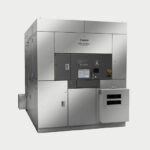ASIA ELECTRONICS INDUSTRYYOUR WINDOW TO SMART MANUFACTURING
Canon Develops Terahertz Device with Highest Output
Canon Inc. develops a terahertz device featuring compact size and highest output1. The device’s high output and high directivity2 were achieved through Canon’s semiconductor device design and manufacturing technology. In the years to come, terahertz technology is expected to be widely used in such fields, as next-generation sensing and data transmission.

Terahertz Potential Use in 6G
Terahertz waves are a type of electromagnetic wave that possess a wavelength between that of radio waves and light while possessing characteristics of both. Compared with widely used X-rays, they are ideal for scanning underneath the surface of objects without causing harm to the human body. Thanks to such characteristics, the use of this technology is expected in locations that experience heavy pedestrian traffic, such as entrances to amusement parks and event spaces. This makes possible security countermeasures with high throughput that do not disrupt the flow of pedestrian traffic.
Moreover, experimentation towards the use of terahertz waves in next-generation 6G signal transmission is ongoing. Thus, there is potential for its use in high-speed, high-volume data transmission.

Resonant-Tunneling Diodes
The new device developed by Canon produces output stronger than terahertz waves and more easily directed. Thus, it contributes to technological innovation and product development in a wide range of fields. Also, it will assist in the development of industries and societies that utilize terahertz wave technology.
Specifically, devices that generate terahertz waves require a high electrical output, and therefore large-sized components. This is one of the most pressing issues for terahertz technology. However, the newly developed semiconductor device employs Resonant-Tunneling Diodes (RTD)3, which is characterized by the emission of terahertz waves from an “active antenna,” i.e., an antenna integrated with a semiconductor device. Thus, frequency multipliers4 and other such components utilized in conventional devices are no longer needed, allowing for a device size approximately 1000x smaller5.
Thus far, creating compact devices that utilize RTDs results in lower output. However, Canon has successfully developed an active antenna array. It contains 36 active antennas on a single semiconductor chip and is able to combine the output of all antennas, thereby making possible the highest output of approximately 10x6.
Moreover, there is another challenge facing terahertz wave technology. Specifically, terahertz waves emitted by antennas of conventional devices tend to disperse, and thus cannot travel long distances. Canon’s proprietary design technology enabled the synchronization of all antennas in an antenna array. As a result, the company achieved high directivity, approximately 20x7 that of a conventional single-antenna device, without the need for lenses or other optical technology. This in turn makes possible long-range imaging and signal transmission using a more compact device.
1Among 450 GHz output semiconductor devices. As of December 28, 2022. Based on Canon research.
2Directivity refers to the way in which the strength of an emitted electromagnetic signal or light varies depending on the direction. High directivity means that energy can be concentrated in a single direction.
3A diode that utilizes the phenomenon of tunneling through electron resonance walls originating from nanoscale structures of semiconductor devices. This compact electron device is capable of directly generating terahertz waves at room temperature.
4A device that converts and outputs input signal frequency to integer multiples.
5Comparison of device volume between Canon device and conventional devices such as those using antennas or frequency multipliers and conversion lenses.
6Comparison between a conventional single-antenna semiconductor device (approx. 1mW) and new Canon device (approx. 11.8mW). Based on Canon research.
7Comparison of antenna gain between a conventional single-antenna semiconductor device (non-synchronized, no lens, approx. 10dB) and new Canon device (synchronized, approx. 24dB). Based on Canon research. Antenna gain is a key performance parameter, which indicates ability to accumulate and output signal strength depending on direction. A higher antenna gain means higher performance of the antenna. A difference of about 14dB in antenna gain corresponds to a difference of about 20 times in terms of strength.




